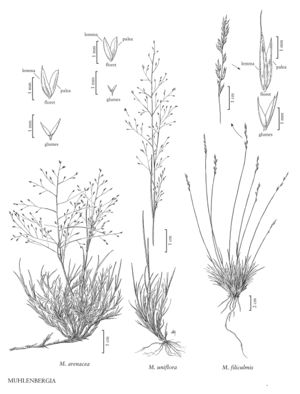Muhlenbergia arenacea
Plants perennial; rhizomatous, not cespitose. Culms 10-30(40) cm, decumbent, terete to some¬what compressed-keeled near the base; internodes scabridulous below the nodes. Sheaths about 1/2 as long as the internodes, margins hyaline; ligules 0.5-2 mm, hyaline, with lateral, 1-2 mm lobes; blades 0.7-4(6) cm long, 0.5-1.7 mm wide, flat, occasionally folded, tapering, scabrous abaxially, strigulose adaxially, margins and midveins thickened, whitish, apices narrow, often sharp. Panicles 5-15 cm long, 4-14 cm wide, broadly ovoid, open; primary branches 2-8 cm, capillary, straight to slightly flexuous, diverging 45-80(100)° from the rachises, never appearing fascicled, naked proximally; pedicels 1-11 mm, usually longer than the spikelets. Spikelets 1.5-2.6 mm, occasionally with 2 florets. Glumes equal, 0.9-2 mm, 1-veined, usually acute to acuminate, occasionally erose and mucronate, mucros to 0.2 mm; lemmas 1.5-2.5 mm, lanceolate to oblong-elliptic, plumbeous to purplish, sparsely appressed-pubescent on the lower 1/2 of the margins and midveins, hairs to 0.3 mm, apices acute to obtuse, sometimes shallowly bilobed, mucronate, mucros to 0.3 mm; paleas 1.5-2.6 mm, lanceolate, glabrous, obtuse to acute; anthers 1-1.5 mm, yellowish to purplish. Caryopses 1-1.3 mm, elliptic, brownish. 2n = unknown.
Distribution
Ariz., Colo., N.Mex., Tex.
Discussion
Muhlenbergia arenacea grows in sandy flats, plains, alluvial fans, washes, depressions, and alkaline mesas in open grasslands, at elevations of 1000-2200 m. Its range extends from the southwestern United States into northern Mexico.
Selected References
None.
